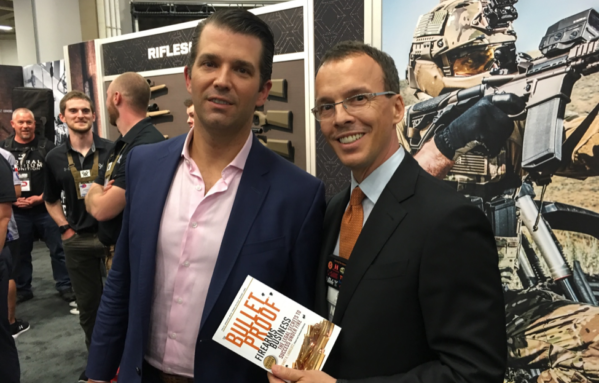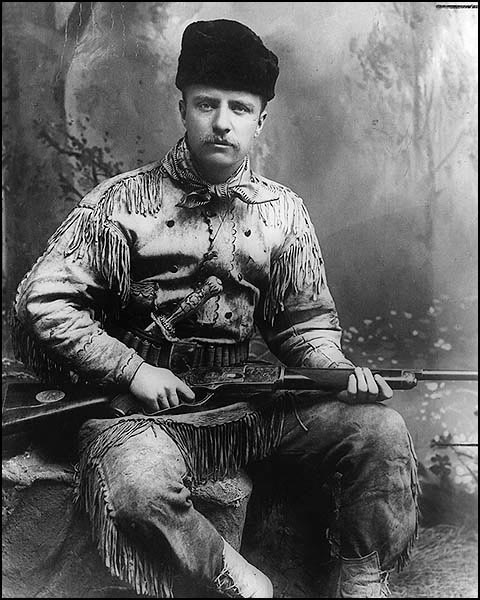By Ben Langlotz
|
June 5, 2018
|
Business, Firearms, Firearms Industry Advice
|
0 Comments
The World’s Most Famous Shooter?

How to Avoid Annoying Fans?
At last month’s NRA show in my hometown, I was happy to bump into Donald Trump Jr. to offer him a copy of my book. As you can see, he’s carrying a shopping bag in each hand. Smart celebrity trick to avoid shaking every hand at public events, and having to accept books being thrust at you from patent lawyers. I trust that the bags weren’t just decoys, but were filled with goodies from every gun company he visited. After all, who wouldn’t want to have such a prominent shooter and gun guy using their gear?
That got me to thinking. Who really is the most famous gun guy around? Is there anyone more famous than Trump who is more famous as a shooter in the eyes of the general public, or the general shooting public? There are those who are famous for other things, and notable for their gun enthusiasm, like Uncle Ted, and a few Hollywood actors like Tom Selleck (preceded of course by Charlton Heston). There are the esteemed authors and experts, but those big names aren’t as well known outside of the industry and their particular fans. Of course, there are the industry names like you see on my back page and on overhead banners at trade shows, but that isn’t quite it either.
I honestly can’t think of a gun enthusiast who is as recognized as Donald Trump Jr. Even his detractors know him as an African hunter, and we also know of him as a silencer fan and a gun rights advocate with the President’s ear. It’s easy to imagine Don Jr. as the face of the NRA in future years, but he might have bigger things in mind.
So, if Don Jr. is the most notable shooting enthusiast or gun nut in the present day, who is the most notable of all time? My nominee is an historic figure whose image is recognized worldwide, and universally in our nation. An image of him holding a firearm would be unsurprising to anyone whether or not pro-gun. I’ll reveal my choice at the end of the newsletter.
Why I Abandoned Facebook
Because it sucks.
Seriously, I used to enjoy Facebook, and it became a meaningful business marketing tool as it probably is for many of you who are reading this. I have written about how growing a personal following helped me to build a following for a separate professional Facebook Page (“Gun Patent Attorney Ben Langlotz”). And how that not only now appears as an additional listing on the front page any time someone Googles: “Gun Patent Lawyer” to push out the hypothetical competition, but gives Google’s algorithms the certainty of my legitimacy to rank my main gunpatent.com web page #1.
So I understand the benefits of Facebook. It’s just a waste of time, and has gotten worse. No offense to all of my friends, but what normal people like us post on Facebook just isn’t that interesting. Who cares what someone had for lunch, or what their legroom on a flight looks like? Who really needs to see the 17th posting of the bear eating the kayak? Or the obviously fake “news” stories about our political opponents that actually make us look less credible? It’s nice to share baby pictures until you realize that your child’s privacy is in Mark Zuckerberg’s hands, and you can spend untold hours to remove old posts and photos.
So my Facebook is simply “there” to keep Google ranks happy, and I don’t spend time on it any more. Not even when my liberal friends are obviously wrong and need to be corrected.
Better than Facebook by a Mile
If you’re looking for news, entertainment, and even engagement, and if as I do you prefer people who are smarter than you, better informed than you, and more interesting than you there’s a social media platform to consider. You probably aren’t on it yet, or at least aren’t active on it yet. Yet like I did a year or two ago, you know it’s about time. Face it, in this industry we aren’t always on the cutting edge of social media trends.
But now is the time for our industry to get on Twitter. If Facebook is about boring people posting about things no one cares about, Twitter is about your ability to tap into the most interesting people and topics you care about.
I like knowing what @realdonaldtrump has to say, several times per day, without having it filtered by a hostile media. I like seeing what news stories Tom Gresham of @guntalk thinks are important, or that the Crime Prevention Research Center’s @JohnRLottJr thinks might interest his supporters. Note that those “@” signs refer to a person or organization that has a “feed” you can follow. A “#” hashtag indicates a topic that anyone can post to by including that tag – I don’t use that much – but imagine #SHOTShow2018 as a place for Tweets (a short post or link to an article) by anyone about what’s happening at the show – or #gunpatent for items on that fascinating subject.
The next cool thing is that when you follow the feeds of people who share good stories, you also end up finding other Twitter users who have good feeds, and can follow them – like a friend introducing you to a new friend. It’s also easy to “unfollow” so that if you follow someone who had one fascinating Tweet (posts) and then it turns out that everything else they post is about urology you can end the relationship quickly.
Some other tips are not to follow a big company like Fox News, as you’ll just see what their interns are posting. Instead, follow your favorites individuals, and see what stories Tucker Carlson or Greg Gutfeld thinks are important.
This will probably sound self-serving, but the very easiest way to get started is simply to follow one person you think might share some interests with you. Like me, @GunPatent. I’m not out to monetize a big Twitter following so I don’t need “followers”, but I’d simply like to see more of our industry community on a platform that isn’t a mind-numbing waste of time. You’ll get more ideas from what I tweet (post) and retweet (share) to create a feed that works for you.
Incidentally, when I settled into Twitter and really started enjoying it as I would enjoy the arrival of a favorite newspaper or magazine years ago, I realized one thing about my feed: It was all people who had written books (including historians, scientists, action novelists, and political commentators). It turns out that authors are good at writing brief and interesting stuff, and have something worthwhile to say. You might find interesting patterns when you switch from reading the posts of perfectly nice normal people who know you, to those of extraordinary people who can inspire.
When it gets really interesting is when you start following the unknowns who have extraordinary insight and information that is simply unavailable elsewhere, and might make you better informed than 99% of people you know. My feed has a few of these odd gems. Let me know if I can help, and I look forward to following you.
Happy Endings in the Patent Process – The Exit Interview
When a patent client gets the good news that we have succeeded in getting their patent application allowed, they get one more benefit – another phone call with me.
Because I’ve seen so many bad patents and disappointed patent owners (invariably on the other side of dispute) I want to be sure my patent clients know exactly what protection they are really getting. Of course, I’d love simply to pat myself on the back for doing great work and helping my client make a dream come true. But this is the time for the devil’s advocate.
Imagine your new patent being analyzed by your worst competitor. You’ve accused them of infringement, and their sharpest technical expert is conferring with their cleverest patent attorney. They’re looking for any weakness they can find in your patent.
That’s how we approach the exit interview. We talk through every word of every claim, because I want to be sure my client understands exactly what is and isn’t protected. Often, we’ll be quite happy with the protection. But we might ask ourselves if one of the words is really necessary. Or whether a competitor might exploit some limitation to “design around” the patent.
As I’ve written about the benefits of the “Keep-Alive” strategy, even when we’re happy with patent protection there can be a big benefit to file a Continuation application to give us ongoing strategic flexibility. This can come in handy when an accused infringer comes up with a “weasel-word” interpretation of the patent, or provides close prior art we didn’t know about. We can pursue different claims that avoid these concerns to inoculate the new patent against the same defenses.
When we see a word or limitation that might be omitted, that can be a good basis for the “Keep-Alive” application, so we don’t just get the benefit of keeping strategic options alive, but we also are working toward potentially stronger protection.
The important thing our call does is to set realistic expectations. It’s not unusual for an inventor who “gets a patent” to have the mindset that the product is “patented.” But the reality is often that there is a particular feature or set of features that are patented, and competitors can sell products that lack those features. By going over the allowed patent claims with my client, it clarifies exactly what’s protected. That helps them to make a good decision about pursuing more or better protection.
Other times, the patent application will have a second invention that is disclosed, and we can pursue protection for the novel features that provide the second benefit.
After 28 years of practice, I’ve come to realize that one of the most important ingredients for a successful legal and business outcome is that of good communications that set realistic expectations. When in doubt, pick up the phone!
My Choice for Most Notable Gun Enthusiast of All Time

Teddy Roosevelt with Winchester Rifle